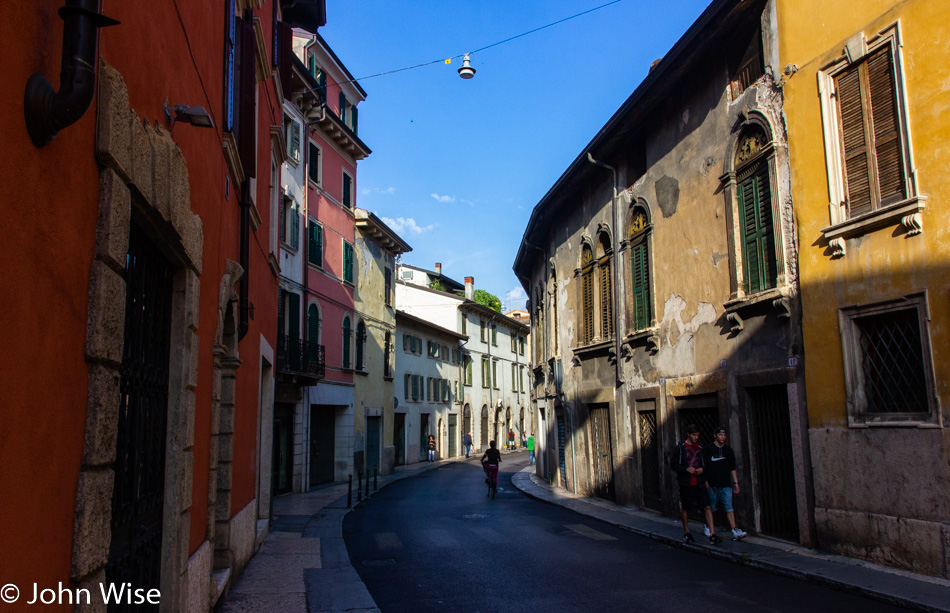
We wake to beautiful blue skies and fall in love with the neighborhood; we are staying next to the Adige River. This beats any hotel in a commercial district as it lends itself to the feeling that we are, for the moment, locals.
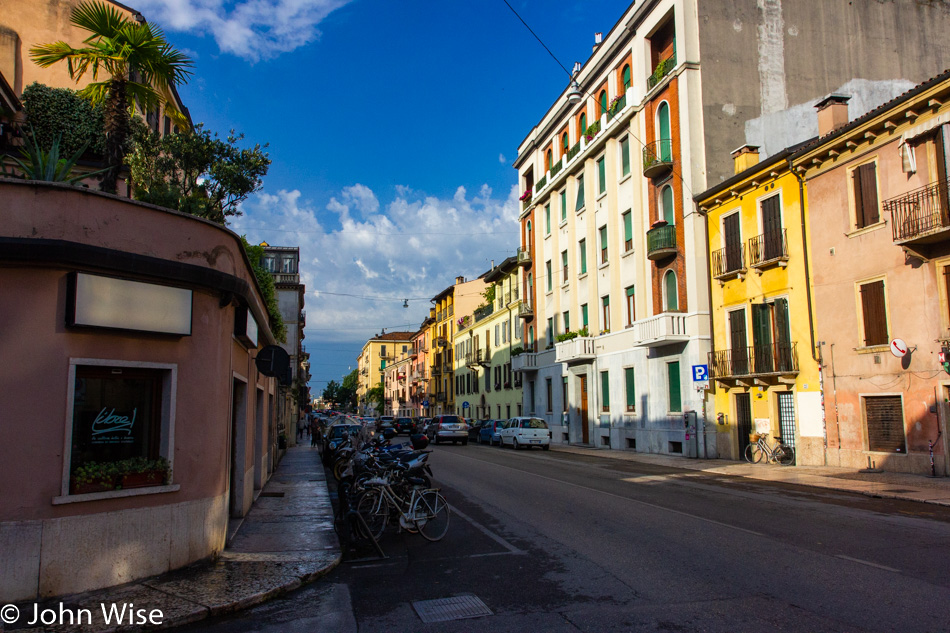
As much as I love the wilds of Alaska or the geological history of the Grand Canyon this forest of buildings on the streets of Italy is hitting all the right notes for me. How in the world did Caroline and I get so lucky in life that we should be able to explore places from the White House to the Florida Keys and across the ocean to scattered locations across Europe?
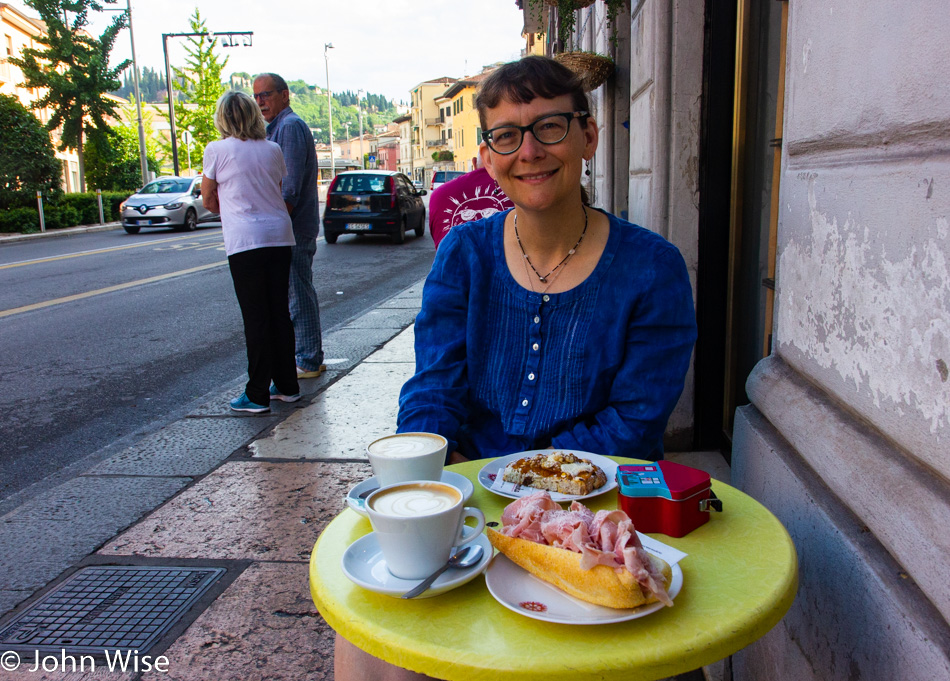
Our host recommended this little breakfast place around the corner to us last night, and sure enough, it was just our speed. We do not need trendy perfection and are just as in love with funky grunge as we were when we were in our 20s. Caroline opted for a slice of toast with apricot jam, walnuts, and some butter, while I got a roll with some ham, and we both had our first cappuccino in Italy.
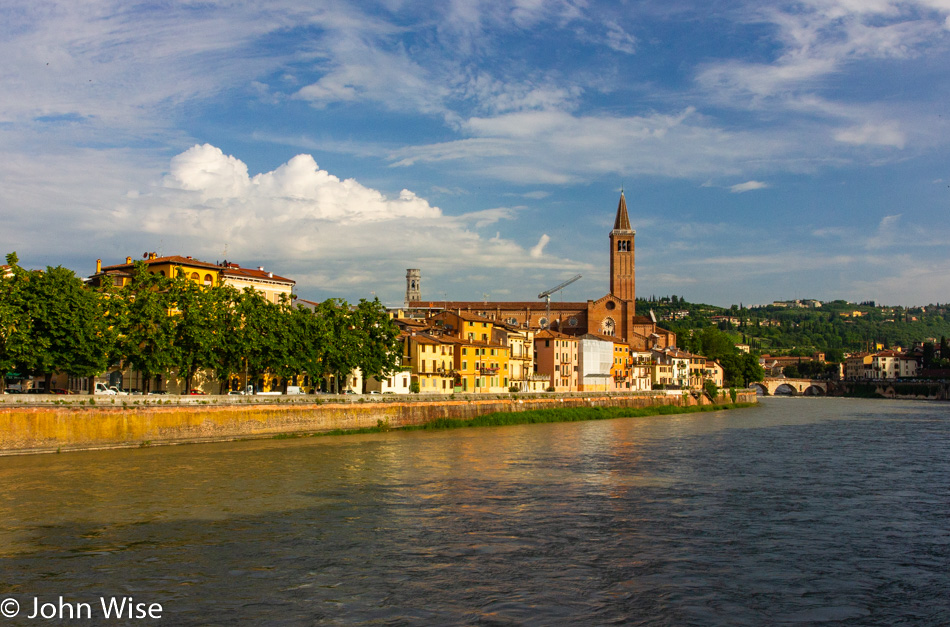
The old town of Verona lies on the opposite side of the river from where we are staying, but like I wrote yesterday, it’s only a couple of minute’s walk away. After breakfast, it was time to explore Verona in the light of day and maybe under some heavy clouds that were bearing down on us from behind me as I took this photo.
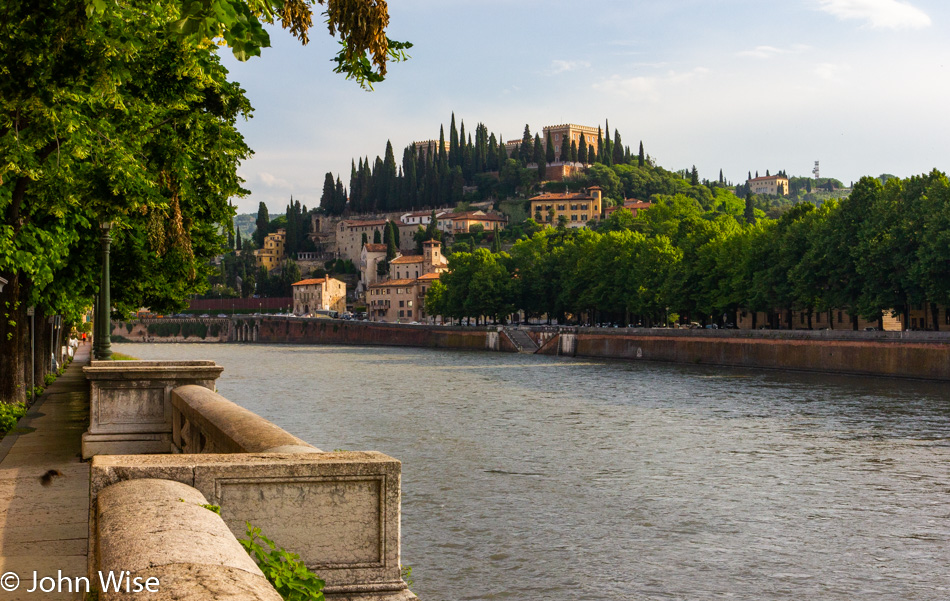
While it was just over there, we never got the chance to make it there. I’m talking of the castle on top of the hill across the Adige. In contrast, I think about the Mississippi River, which, for the majority of its course, looks about the same on both sides of its banks, where this could be two different universes in my imagination.
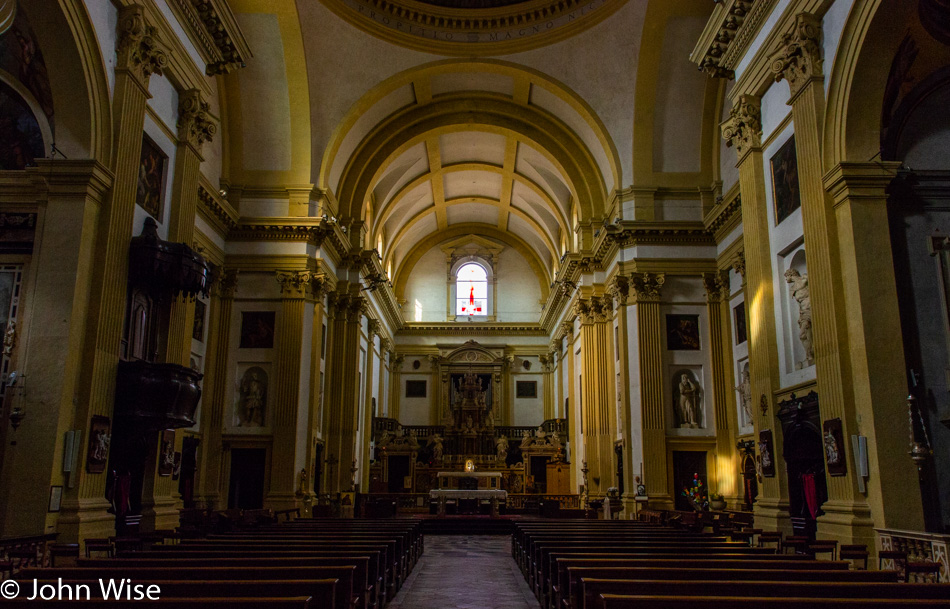
I probably should have gone into this vacation with a predetermined method for tracking what I was photographing, but instead, I just started taking photos. At some point, I will start capturing the signs on the front of the churches as well, so I can share where exactly we are at. Caroline here – this is Chiesa di San Nicolo, also known as the Church of Saint Nicholas or the Church of Teatini. It was built in the 17th century.
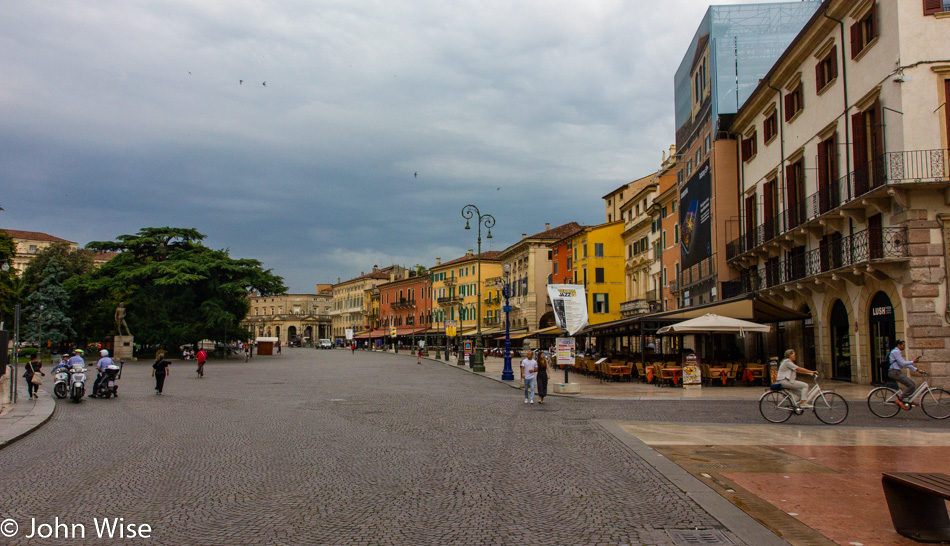
Remember those looming dark clouds I told you of that were behind us? Well, they are moving in quickly overhead.
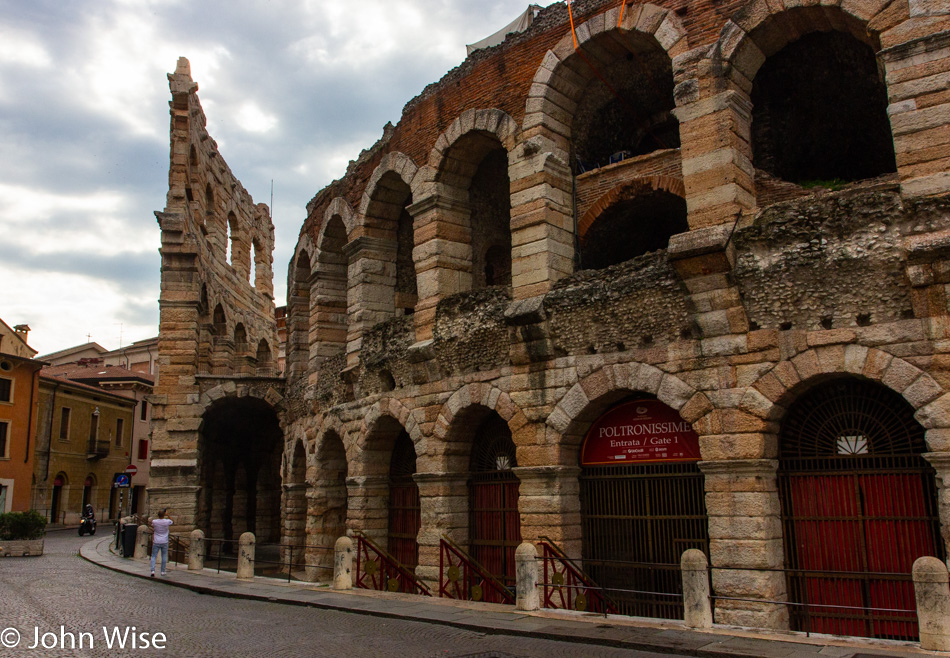
To the left is the only surviving part of the Roman outer ring that has stood there since 30 A.D. when the coliseum was originally built. Today the facility is used for hosting operas and concerts from June through August.
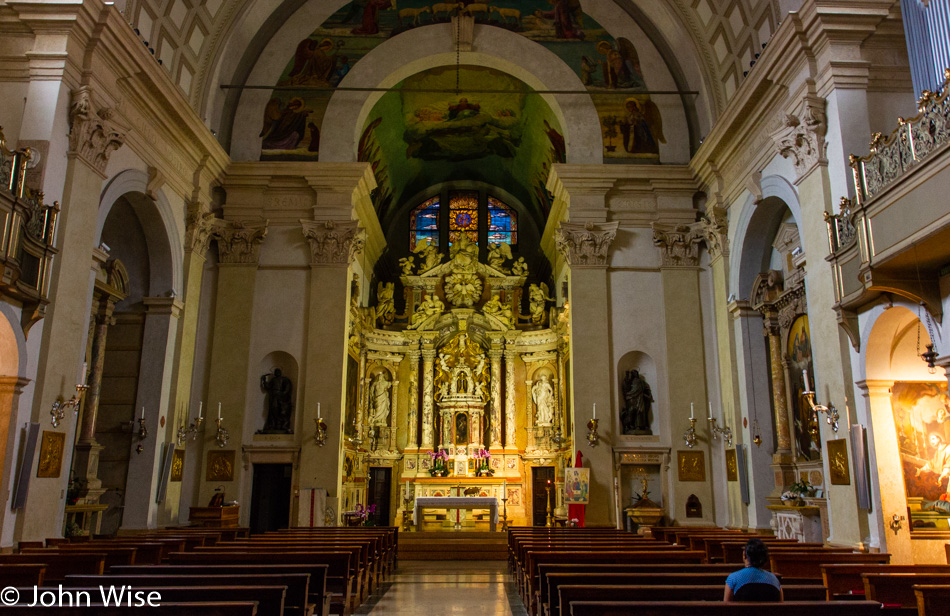
Anonymous church number two. Once I get home and start editing these blog entries, I’ll do the research to match the interiors to already identified churches and maybe even write something witty about our visit, but probably not. Caroline again – this is Chiesa di San Luca Evangelista, or Church of Saint Luke the Evangelist, on Corso Porta Nuova in Verona.
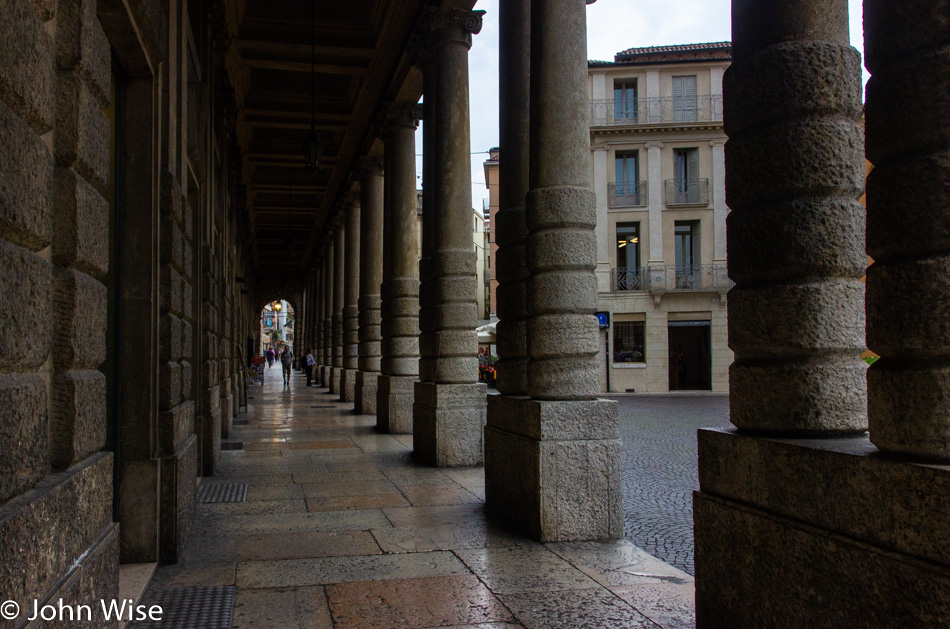
A city without colonnades is like not having a local Walmart. Trust me, it was hard to write that, even though it was tongue in cheek, as no Italian city should ever be spoken of along with Walmart in the same sentence.
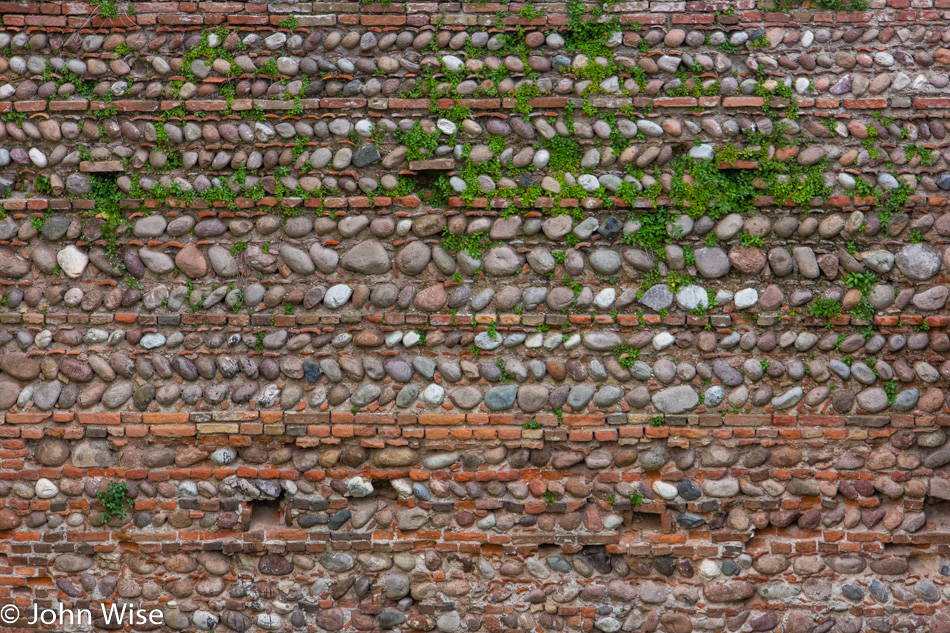
Verona was founded back in 550 BC, so it’s had a couple of millennia to explore surfaces, facades, and streets. During the intervening couple of thousand years, the old place has held up very well.
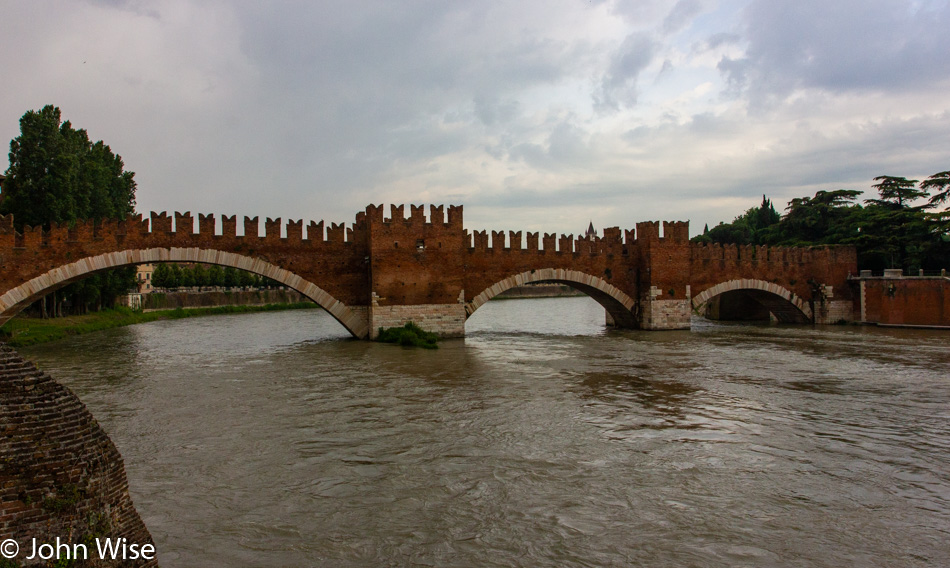
This is not the Ponte Pietra built back in 100 BC which is probably one of the most photographed Italian bridges next to the Ponte Vecchio down in Florence. This is the bridge that was crossing the Adige where we happened to be, so that’s that.

Don’t think for one moment that Italy doesn’t have enough churches. One might even start to believe that there are more churches than there are pizza shops. Santi Apostoli on Vicolo Dietro Santissimi Apostoli – C.
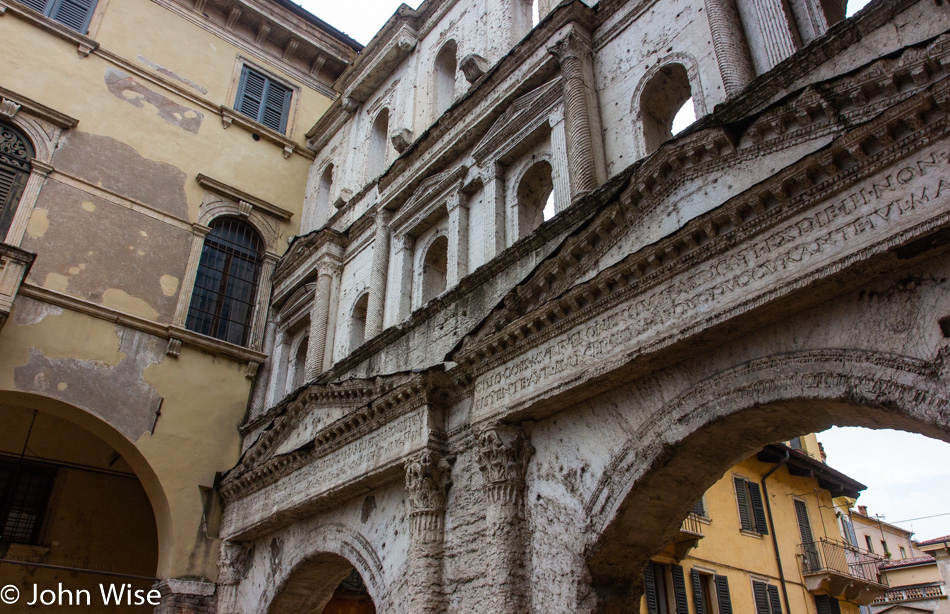
More Roman ruins were found in the old city center. Just the idea that these are still standing after 2000 years is mind-boggling when one thinks that the average American home is built to last about 30 years.
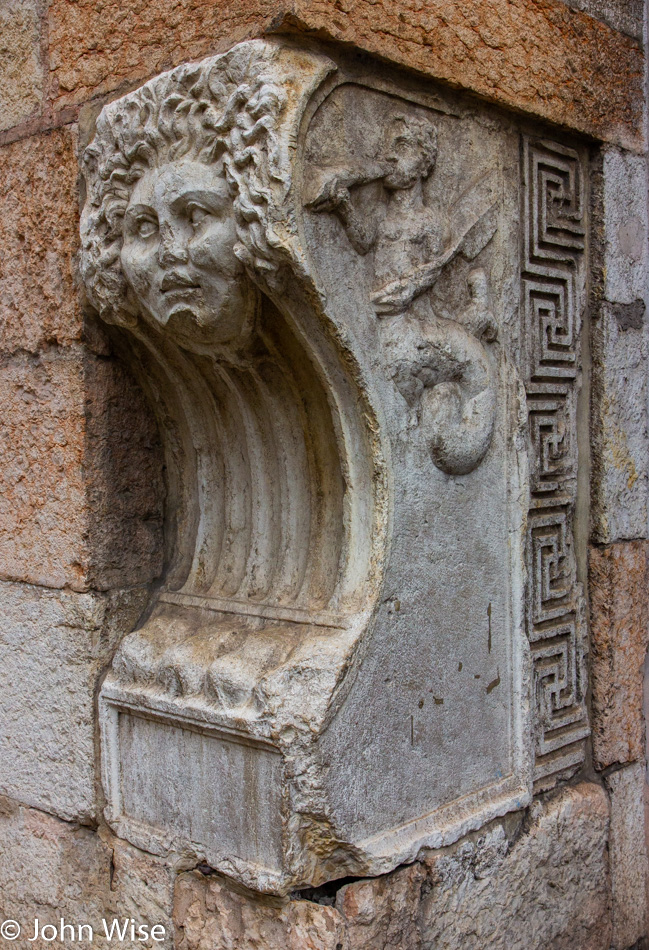
These random adornments scattered throughout the old town on various buildings add that certain something that continues to draw the visitor further into the architecture of the region as we look for these little treasures.
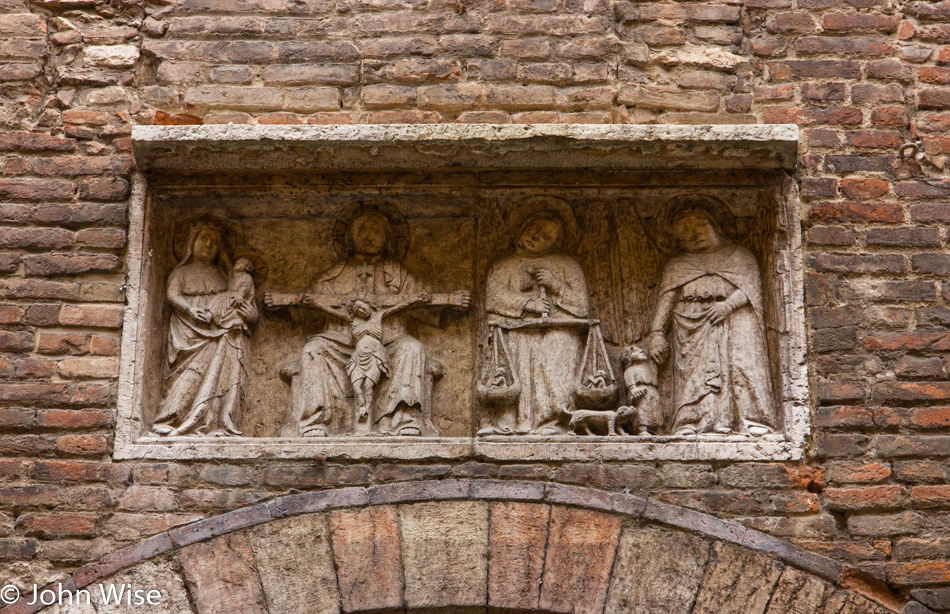
The older architectural artifacts start to become like ancient physical graffiti that was meant to last for centuries.

Is that a church down there? We must go.
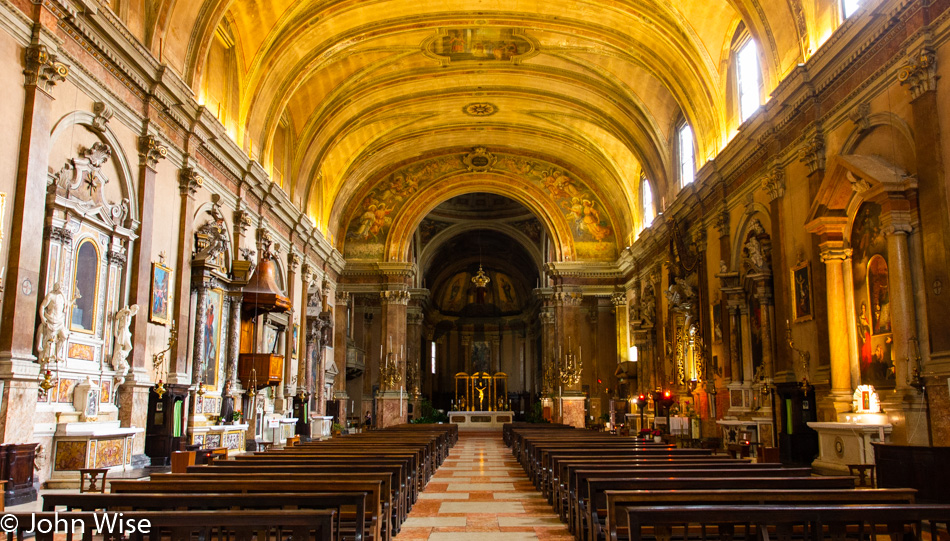
One of the simpler churches. Chiesa di Sant’Eufemia – C.
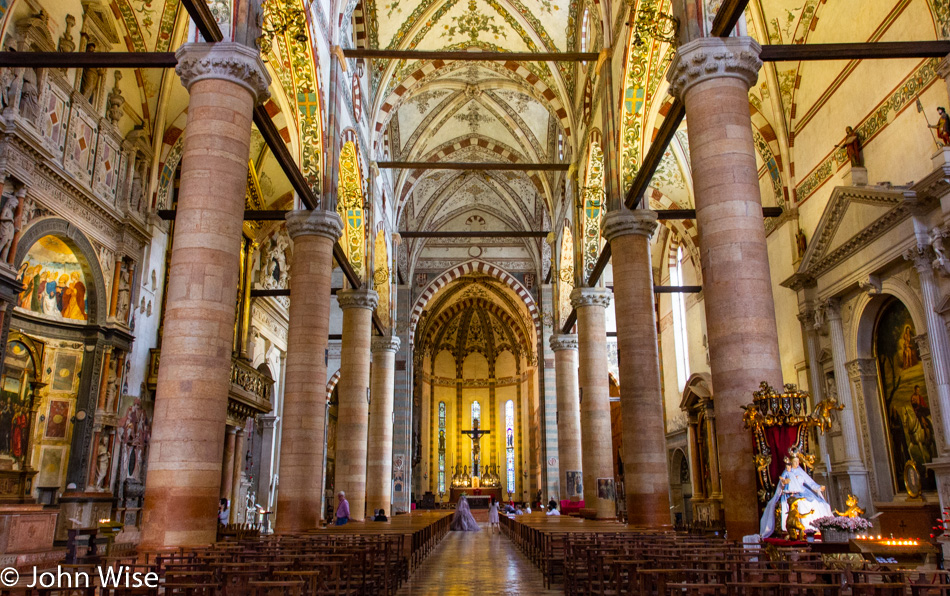
Around another corner, we arrive at yet another church. This time, it is the Basilica of St. Anastasia.

Major construction occurred between the years 1280 and 1400, and the church was finally consecrated in 1481.

In the top left of this image, you can see the bottom of a dress; there was a very beautiful young woman being photographed here during our visit. I thought it was related to an upcoming marriage, but Caroline thought it was simply a fashion shoot.

The organs in many churches are not only integral to the formal use of the building for religious purposes but also play a role in the extravagant art that is here, dazzling the senses.

This basin for holy water, also known as a “stoup,” is one of the most interesting ones I’ve ever seen. Adjacent to this one is another that features a different statue, but you’ll have to google it or visit yourself to see it.

I promise that subsequent blog entries from this trip will not feature so many photographs from the many churches we will inevitably visit. Then again, you know what they say about promises.
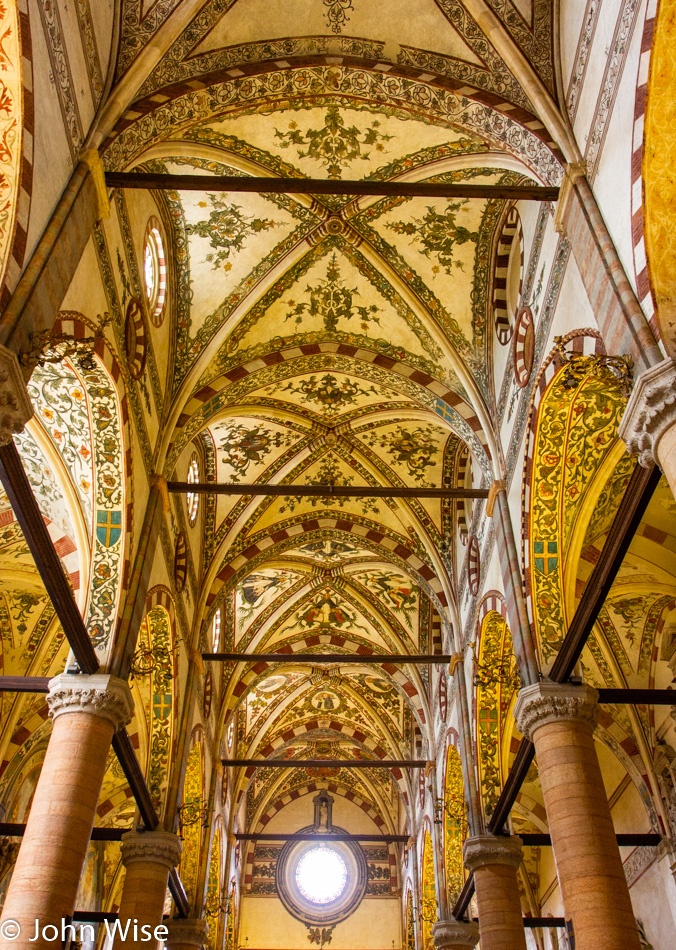
Every angle around every corner delivers something new to behold.
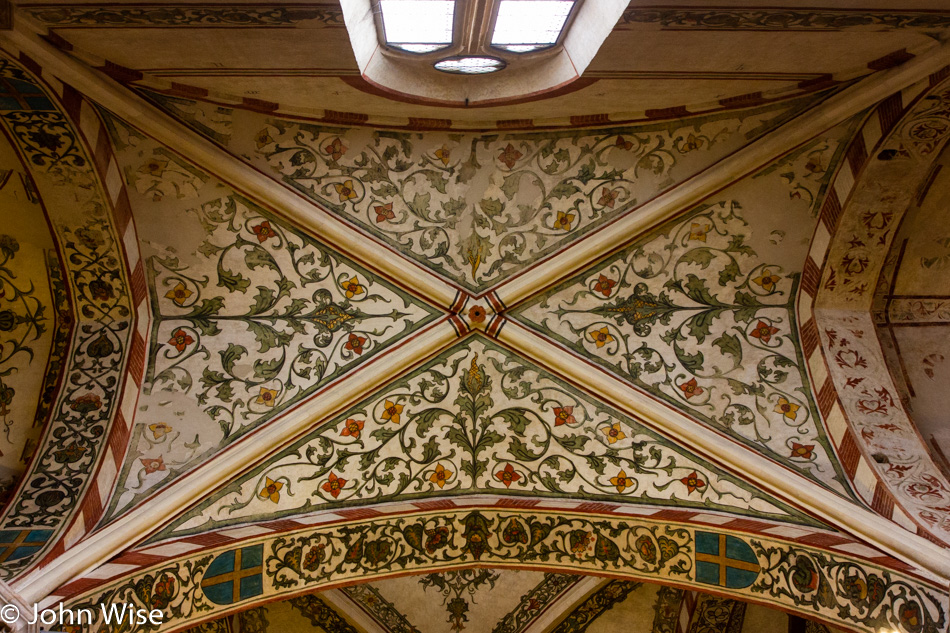
And the closer you look, the more there is to see.

Just because you saw the overall picture doesn’t mean you’ve seen it all. The brevity of time we have in each of these locations demands that we have so many photographs so when the moment of reminiscence strikes us, we’ll be able to look at those and, along with whatever narrative I have added here, return to our visit and see things we missed on the first, second, or even third viewing.
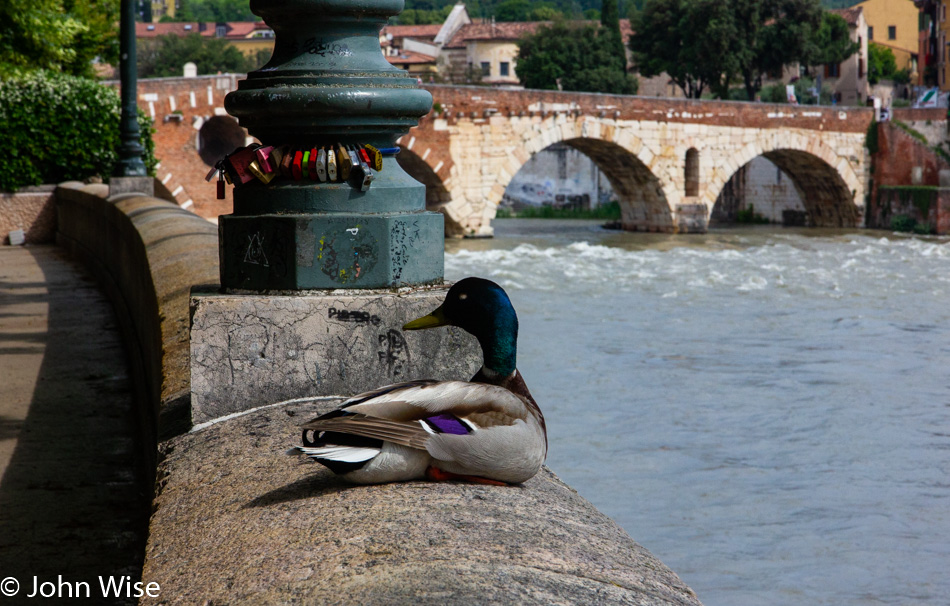
An obligatory photo of Ponte Pietra, but this one celebrates the duck in front of it and makes it the centerpiece. Long live duck culture and their kind for adding their beauty to our world.
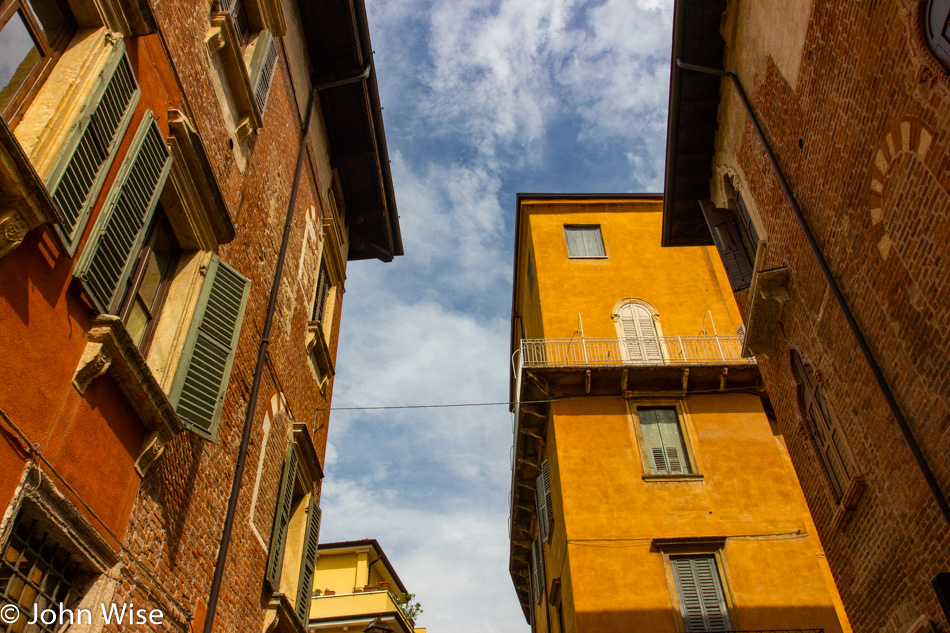
The light and weather continue to cooperate with our travel plans, ensuring we remain enchanted.
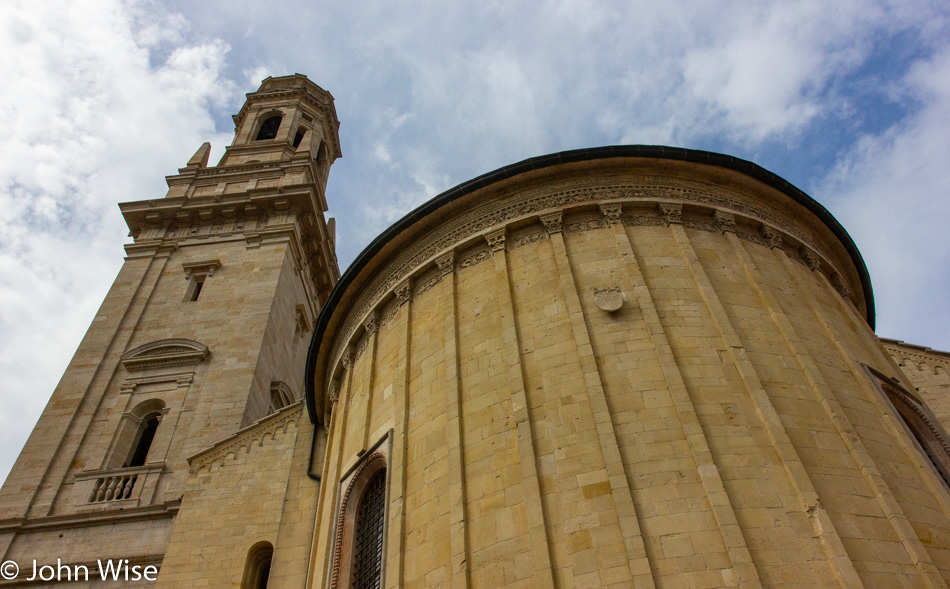
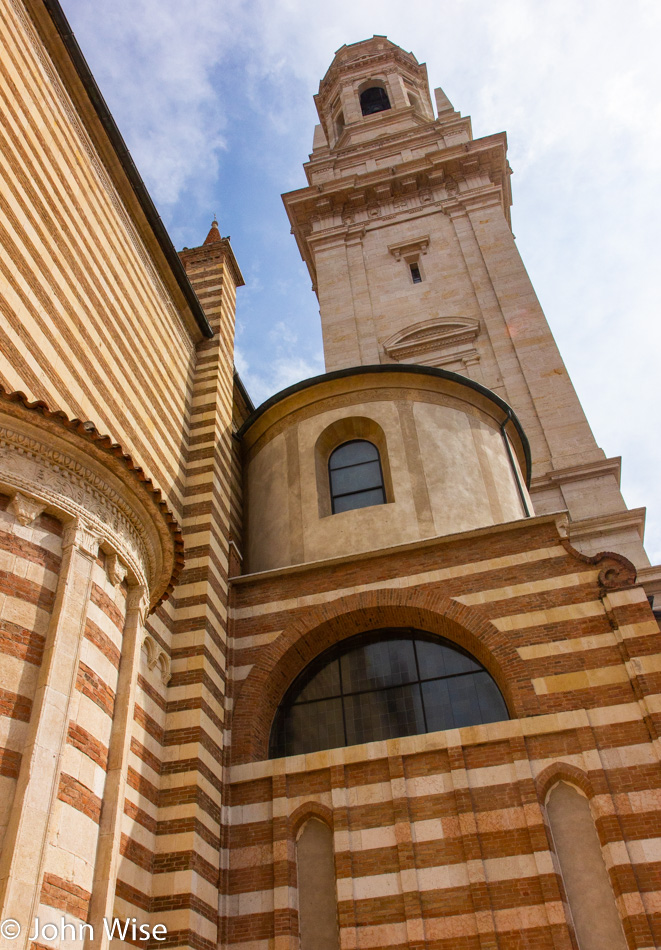
As I said, every angle delivers a different perspective.
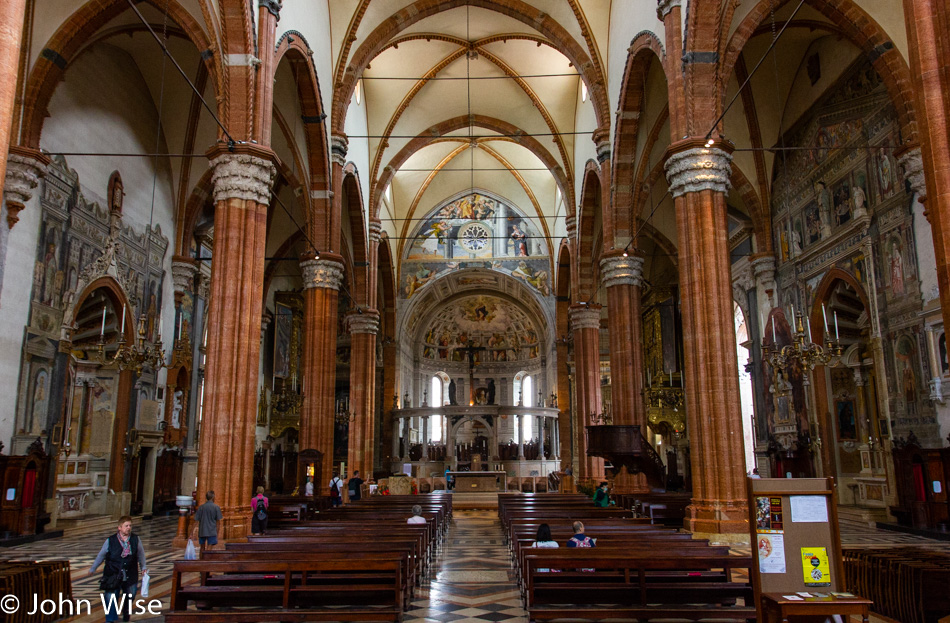
Yet another unidentified church we found along our walk through Verona.
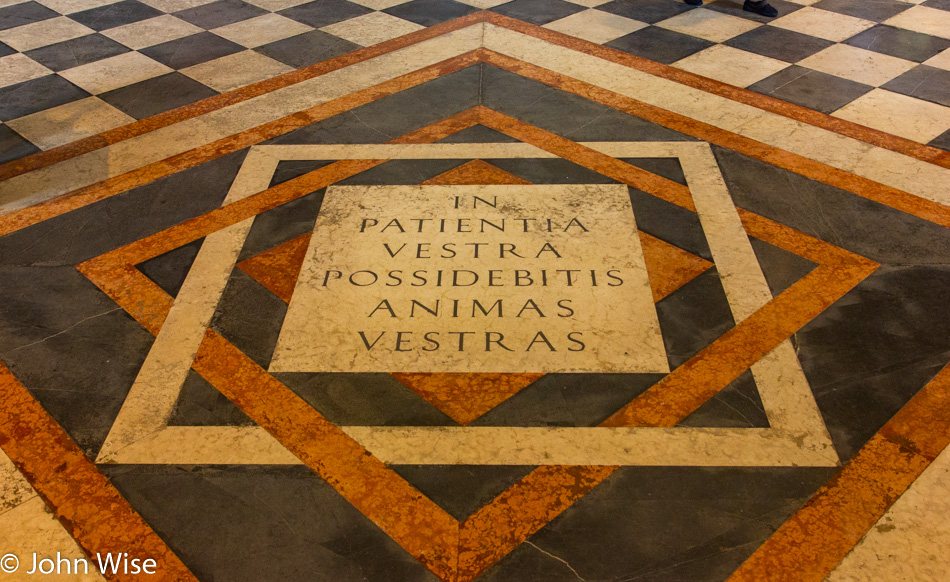
“Embrace your soul with patience.”

I have to wonder if such an ornate church will ever be built again.

The time of day impacts the quality of light, as does the direction the windows point to and how many there are. This is where I should leave a note to myself to try and find a book by an architect from about a thousand years ago who might share his thoughts about building a cathedral and what considerations were made for a building that wouldn’t be done in his lifetime.
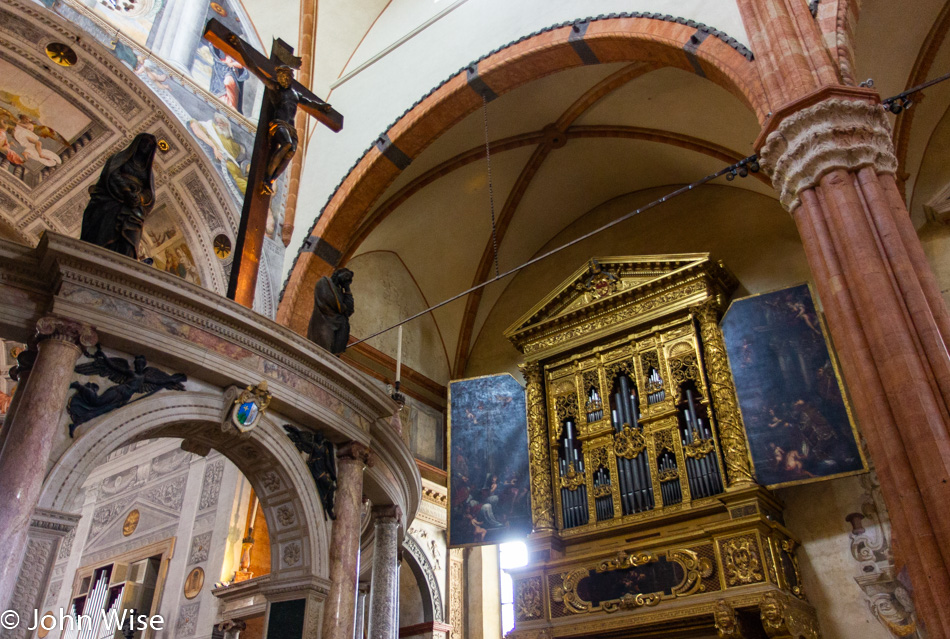
A quick search on Google gave me some answers. The altar and choir are supposed to be in the east, while the nave or central part should be in the west. For dramatic lighting, this makes sense as the light of the rising sun would come through the windows as the priest offers his sermon. This organ is separated into two parts, the gold one is where a transept would have been, and if you look in the bottom left of the image, you can see another part of the organ back where the choir would be.
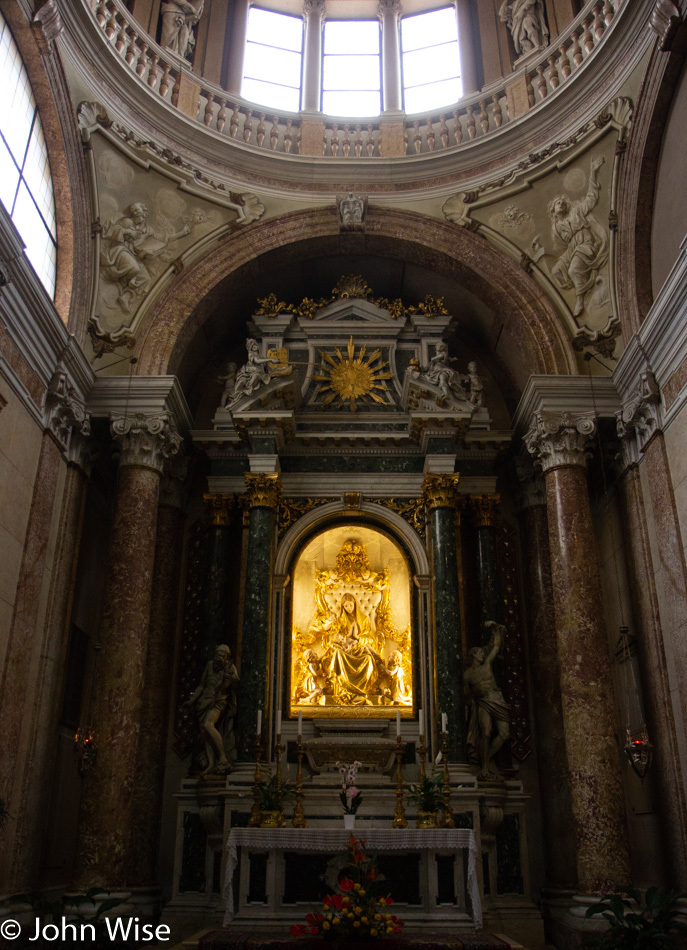
Some of the side altars we find in our visits to these churches are more beautiful than the main altar in other churches. Funny how we’ve seen thousands of images of vacation islands during our lives, but very few interiors of churches, mosques, and synagogues.
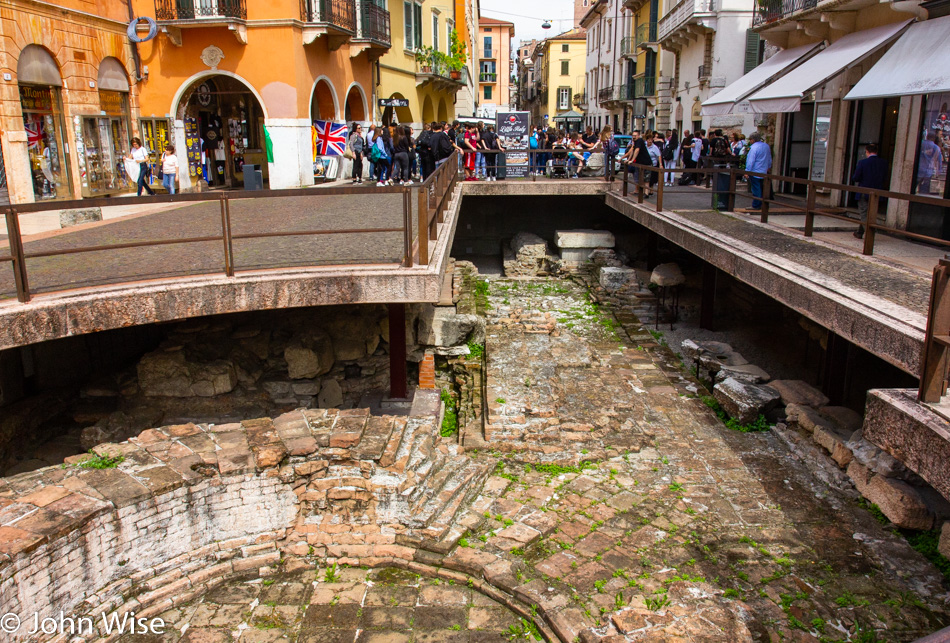
Great way to experience what was the original street level back during the Roman period. This elevation change is true for most ancient cities where successive generations build upon the rubble of what came prior.
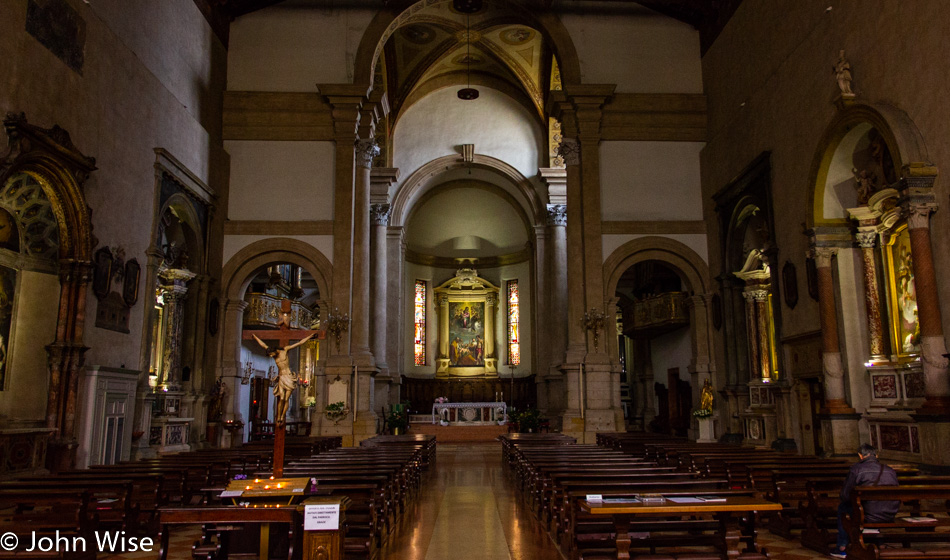
This is the San Tomaso Becket church and the last place we’ll visit in Verona. Afterward, we grabbed another slice of pizza and returned to our car to try and get it out of the narrowest circular driveway I have ever had to use. While I’ve been driving for nearly 40 years now, I’ve never had such anxiety trying to get out of an underground garage. Caroline had to be out of the car, ensuring I did not scrape a corner of the car against a wall. We are off to Padua, Italy.

Our first impressions of Padua had us wondering why we were stopping here. After the art and beauty explosions in Colmar, Como, and Verona, this little place along the road to Venice that is only 24 miles (39 km) away, which was certain to amaze us, was the deliberate alternative to stopping in Venice, one of the most crowded cities on Earth. Our first impressions were underwhelming. Have we made a mistake?
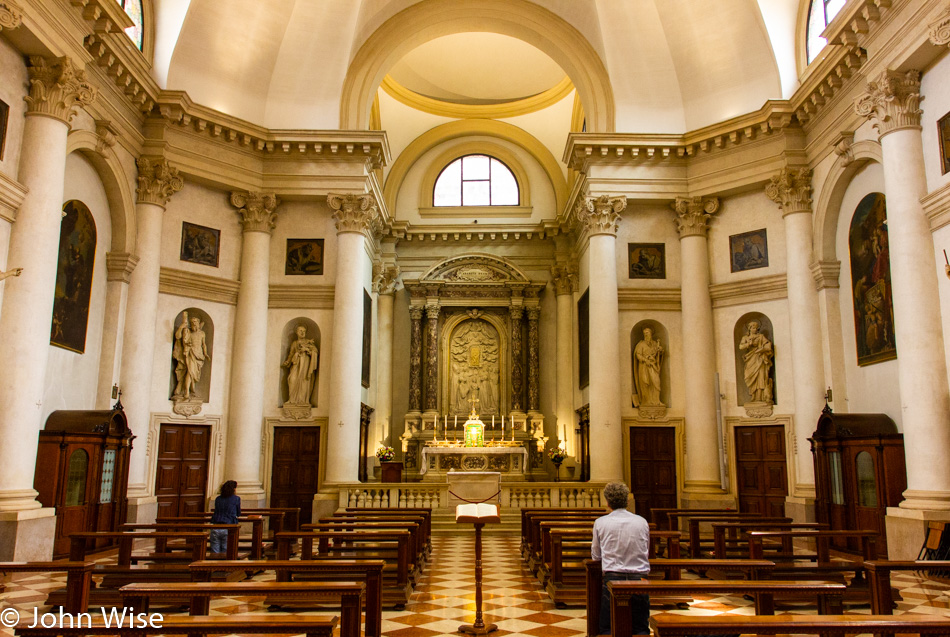
First stop: a church, of course. Praying interrupted by the dumb tourist with the camera that has a shutter that destroys the pristine quiet; yeah, I’m that guy. This is Chiesa di Santa Lucia.
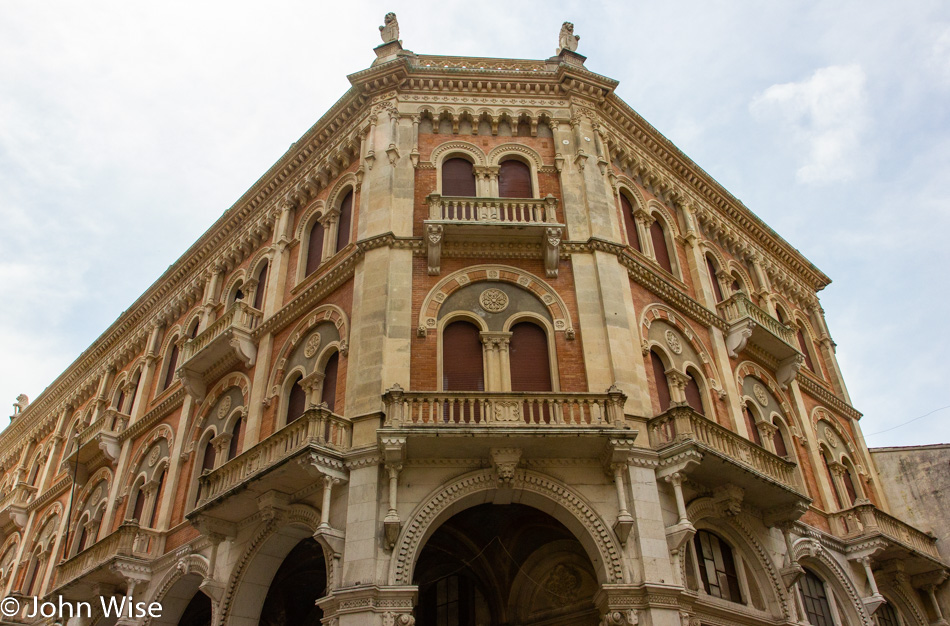
Architecturally, we are starting to see hints of things that allow us a hint of justification for why we are hanging around here in Padua. We are also very aware of how quickly we became spoiled and how high our expectations have become here on the fourth full day of our European road trip.
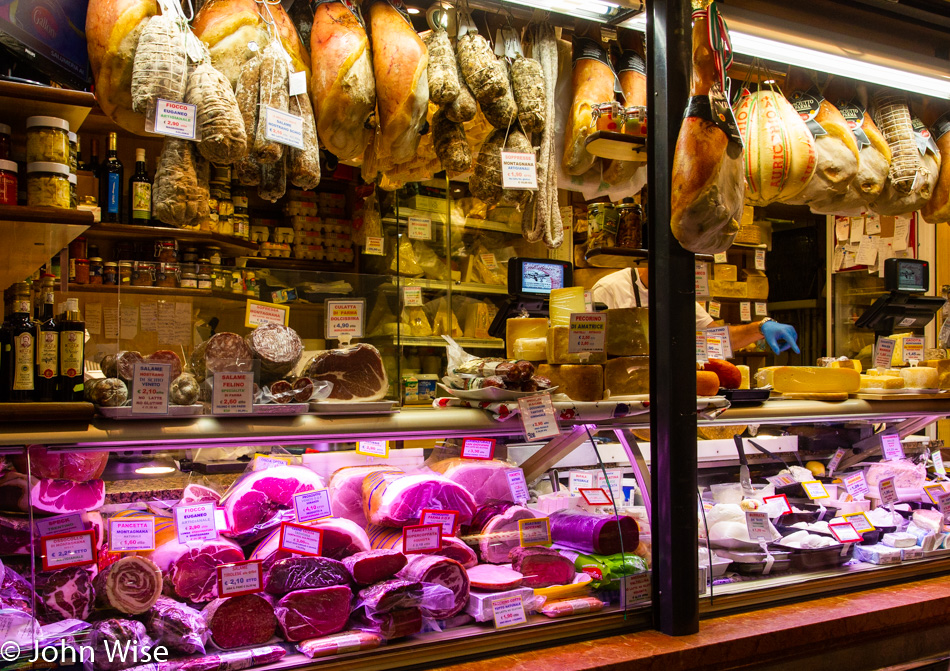
In the shadow of Palazzo Della Ragione, we come upon a mostly open-air market that has been going on at this location for over 800 years. You can learn a lot about people by visiting their markets and seeing first-hand something they typically have to deal with more frequently than anything else other than their jobs and family.
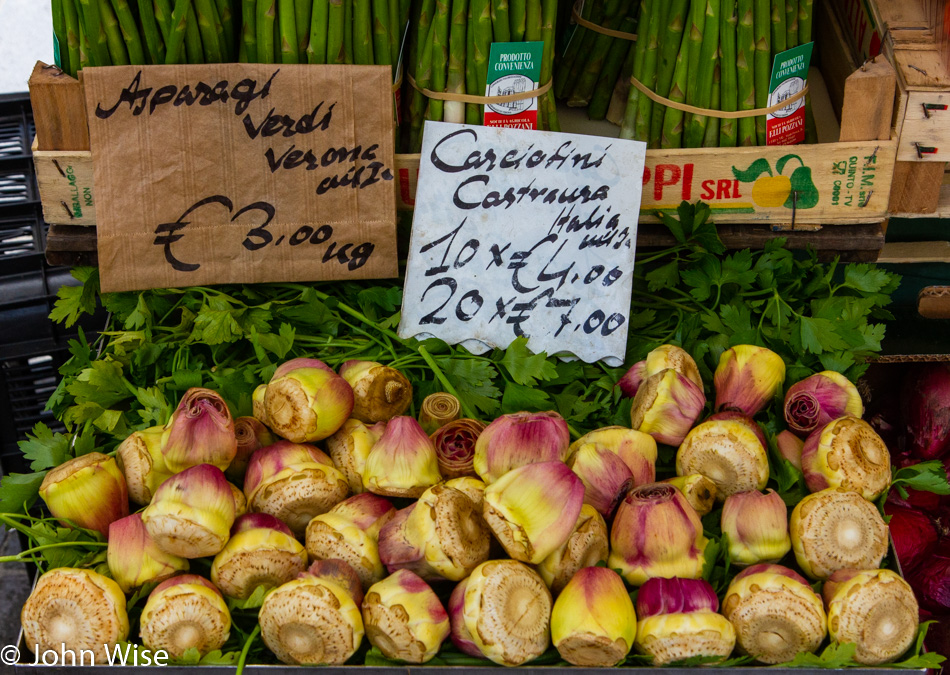
I’d never seen pink and yellow mini-artichokes before this, and now that I think about it, I could see a two-week cooking-in-Italy vacation that would be a nice change from this sightseeing one. Don’t get me wrong, I’m in love with this pure exploration and indulgence journey we are on. Regarding the prices, you get 20 mini-artichokes for about $8.00, and the asparagus behind them is less than $1.50 per pound.
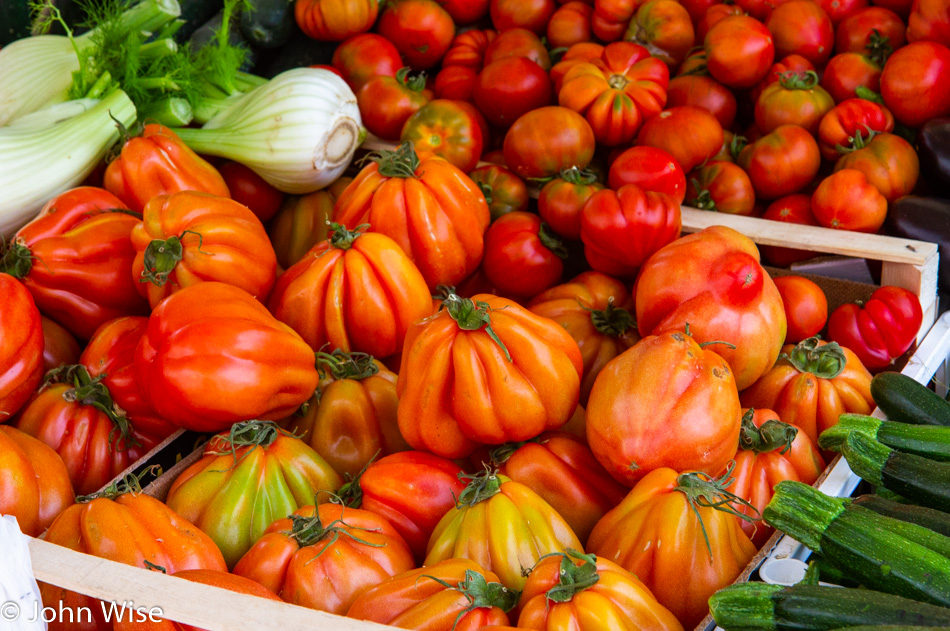
While the tomato may have originated in the Andes of South America, it is Italy that has taken this fruit to extraordinary heights in the culinary world. Seeing the variety of tomatoes, mushrooms, and beans in this market makes my heart sink at the thought of returning to our limited offerings in Arizona. From one of the stalls, we picked up a kilo (2.2 lbs) of apricots for 2 Euros or about $1.00 a pound; this opened up Caroline to identifying this trip with the apricot in all its forms.
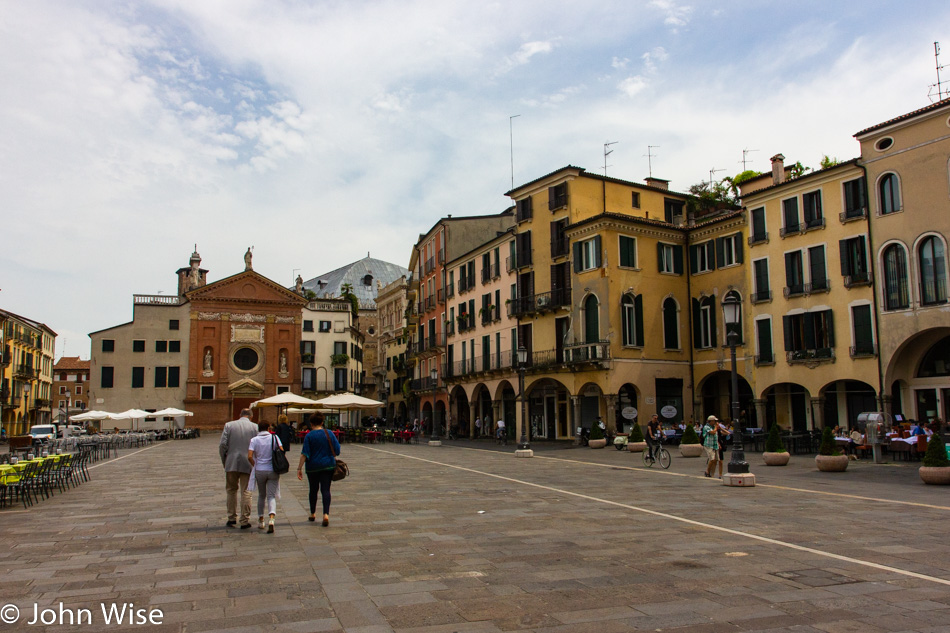
We were still not sold on Padua but weren’t ready to give up on it yet, though we’ve talked about just that a few times already.

The arcades are interesting as having built-in umbrellas would probably be nice during a rainstorm, and in the heat of the day, having all of this shade is great, but how they feel late at night will remain a mystery to us.
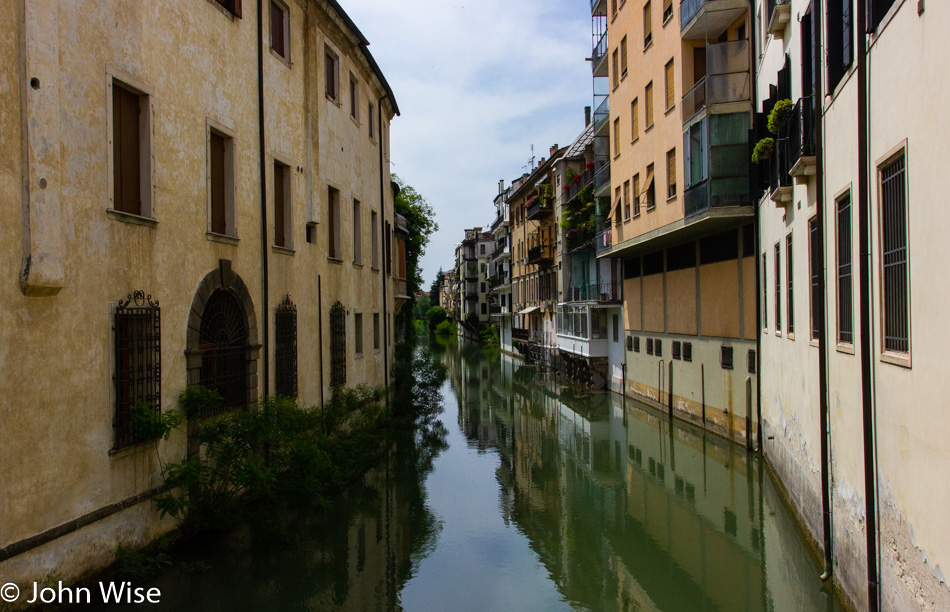
Give me one good reason why all cities shouldn’t have an element of Venice in the form of canals running between houses.
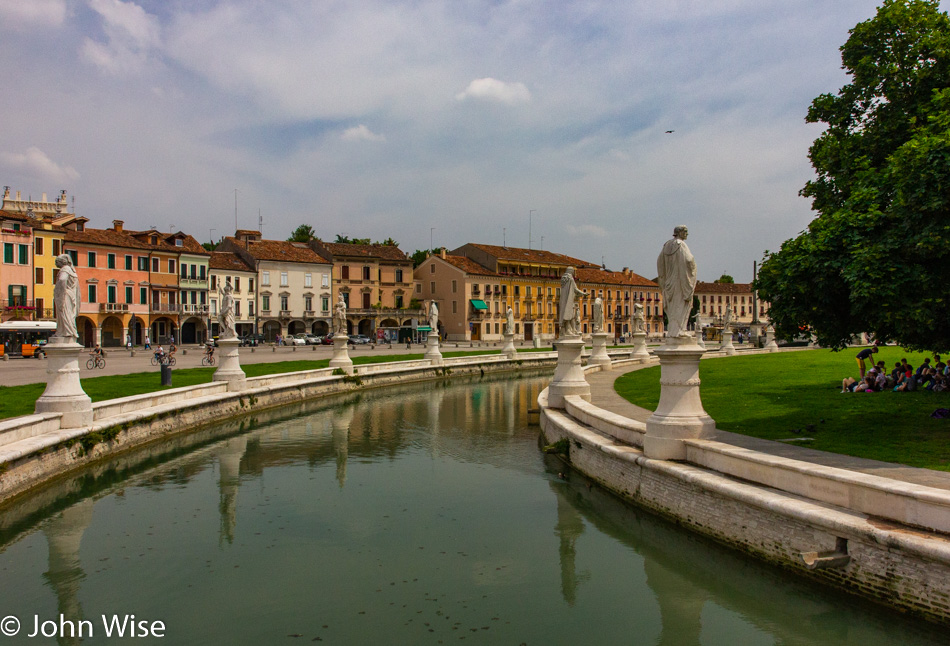
Magic sharks and alligator-infested moats should also be a feature of our major cities, along with sculptures able to contain the beasties. I’m starting to understand the brilliance and imagination found in Padua.

It’s hot and incredibly humid, oppressively so. We stopped here for a couple of Americanos to bring up the energy levels and a large bottle of sparkling water to rehydrate. While walking through town I’ve been carrying my computer as I feel it safer to have on me than to leave it in the car. So, with it, I’m able to do some blogging while having a coffee, which is an added benefit. The church around the corner we wanted to go into was closed for a mid-day break, as was the one we could see from the coffee shop; it was a half-hour until they reopened. The first cup of coffee was gone so quickly it dictated we order a second. Sitting next to a busy thoroughfare and opening my soul was my romantic ideal before leaving for Europe; at the time of having this coffee and blogging, I had no idea that this would be the last afternoon writing exercise I would get to take as our days became even busier.

It must be our love affair with all things watery that draws us to each and every place where water flows.

This is the Basilica of Saint Anthony of Padua, Italy, and the main reason we ended up falling head-over-heels in love with Padua. This is certainly one of the top five churches as ranked by the beauty found within its walls we have ever visited. Unfortunately, photography is not allowed, though I was able to get a few images using my phone, so the quality is not everything I would have liked; at least it was something.
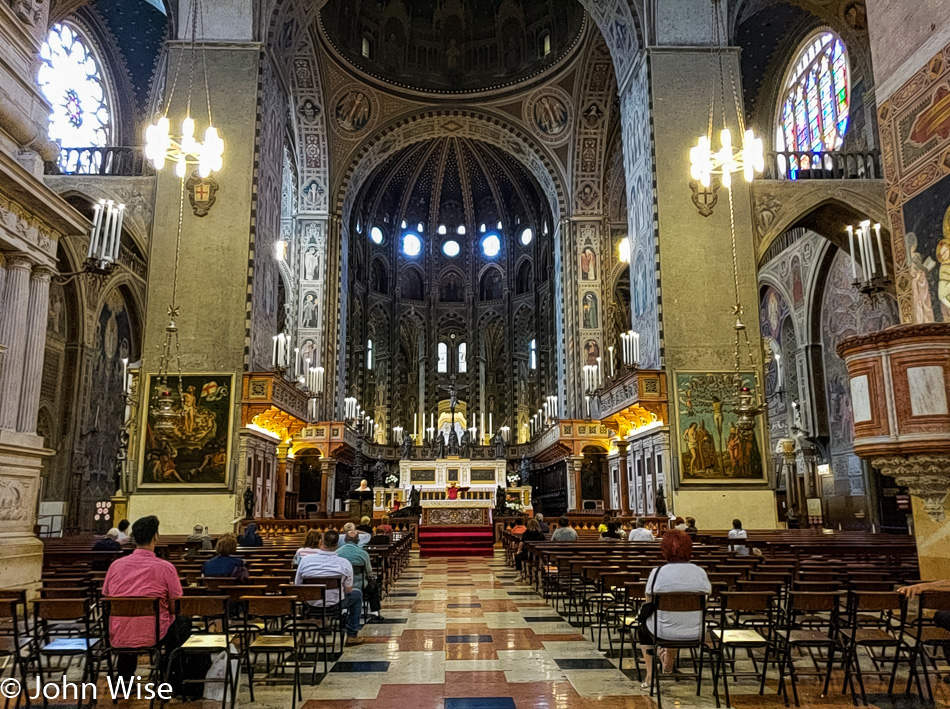
Neither this photo nor any other will ever convey the immensity and ornate environment that exists here. Entering here, you brought into amazement; for Caroline, it was even a teary moment where emotion overwhelmed her.
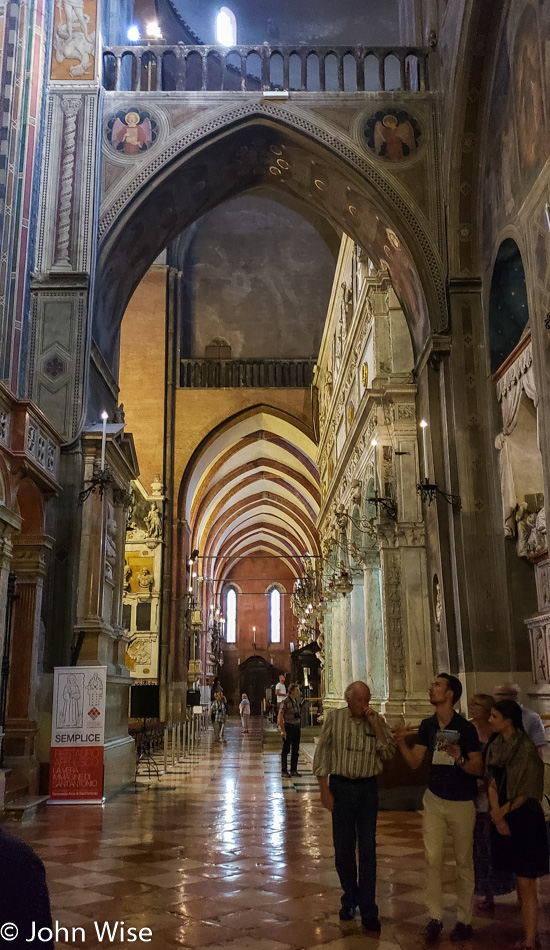
On the right, next to the white marble columns, is the tomb of St. Anthony. While I just had to snap a few images to remind me of this church, I opted to forego a photo of the tomb area out of respect for the deceased saint and his many worshippers. There were two guards posted in the reliquary where the tongue, lower jaw, and part of St. Anthony’s vocal cords were on display.
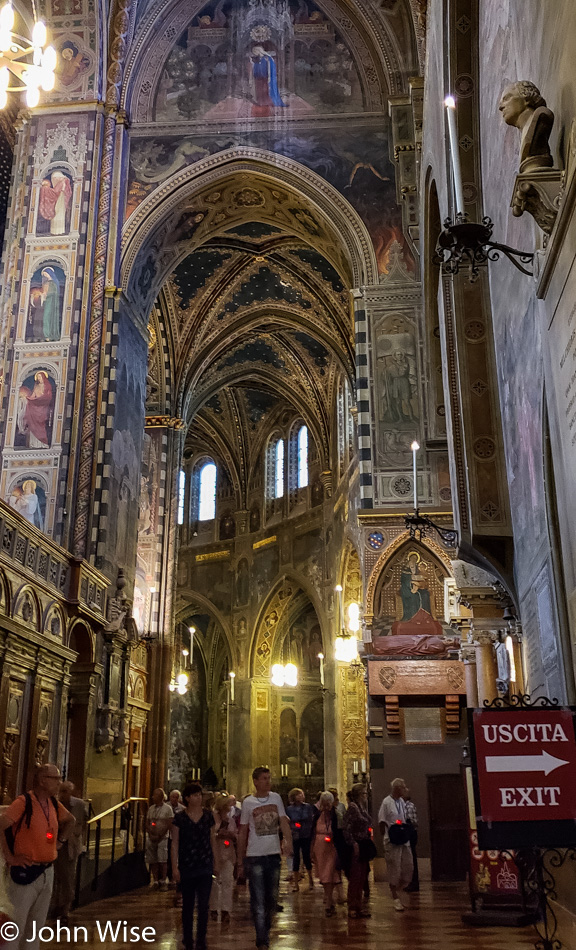
Looking now at posting these feels nearly criminal as they seriously fail in conveying a fraction of what they should. The red dots on the people in this photo are the laser spotters used to shoot visitors caught taking photos.
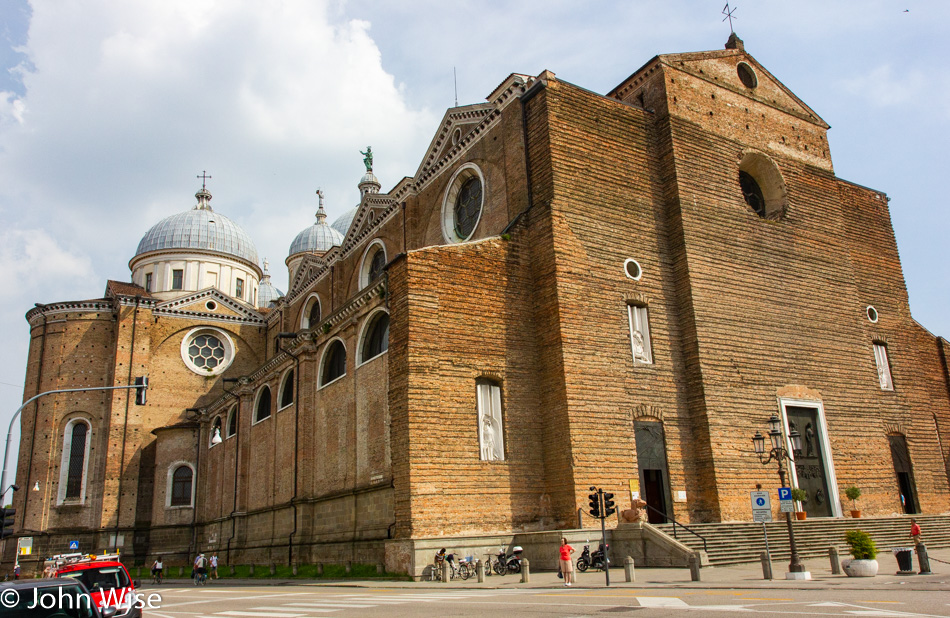
From St. Anthony, we backtracked to the Basilica of Santa Giustina, afraid we might miss something we left Padua now. We are starting to curse the heat and humidity, probably more so the humidity, as we are not used to this level of moisture in the air. The churches become a refuge as they are cool and nowhere can you find air conditioning.

While not as ornate as St. Anthony’s, the grandeur of the interior doesn’t fail to impress.

One of the side chapel altars.
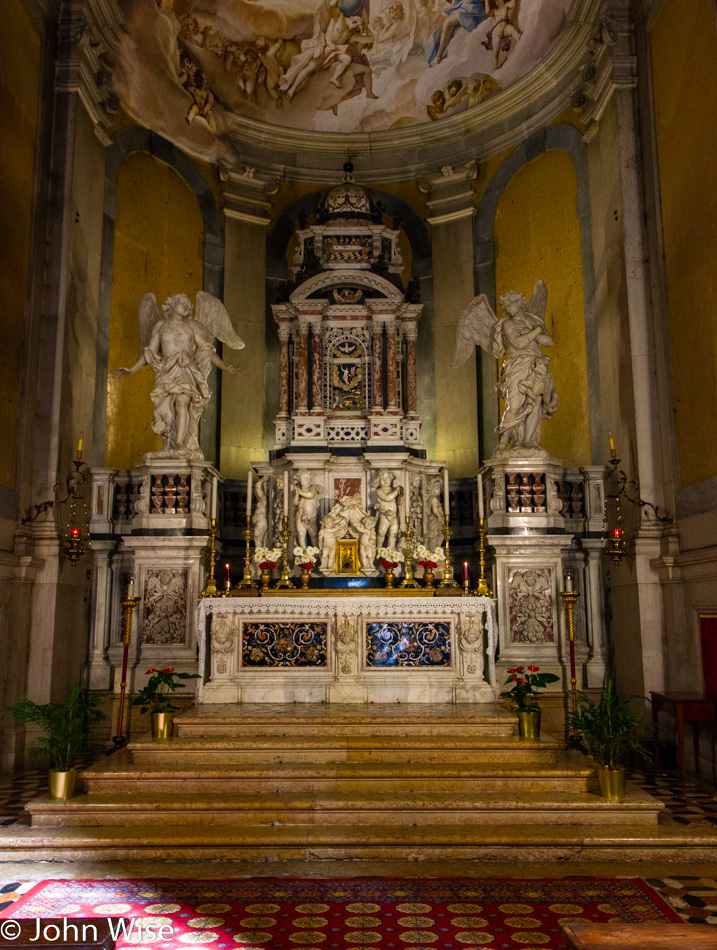
And another side chapel altar that would be extravagant in its own right in any lesser church found elsewhere.

We should all frame the art in our homes with such ornate finery.
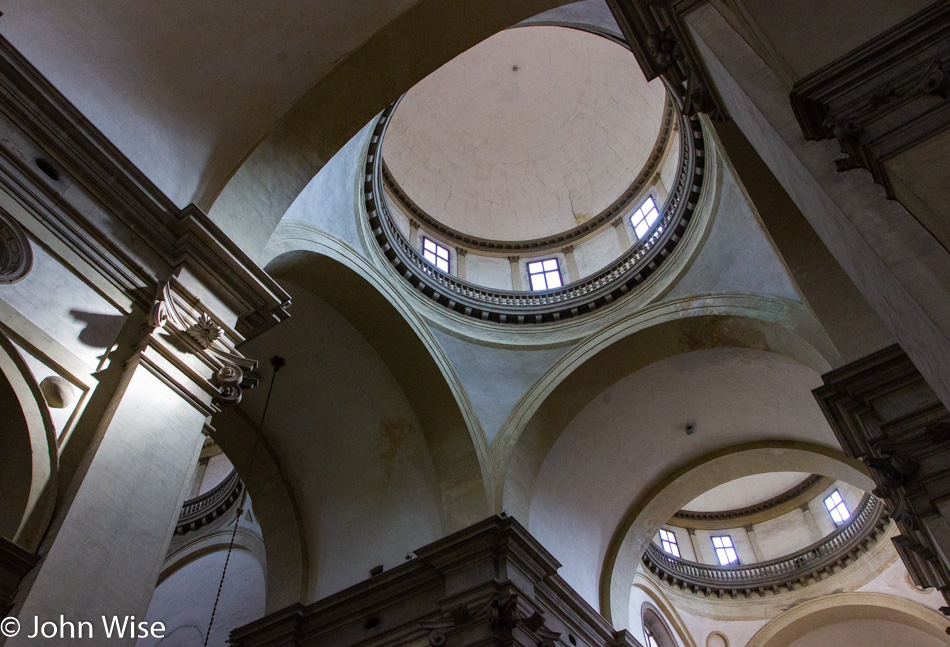
Angles, lines, and circles are pulled together with a lot of gravity and mathematics. I only need about a half dozen images to feel like I’ve adequately conveyed what the overall impression within a church looks like. I wish I could have done this with St. Anthony’s.

We are now heading back to our car as we have a couple of hours driving to Gorizia, Italy, on the Slovenian border. We do a lot of window shopping on these trips.
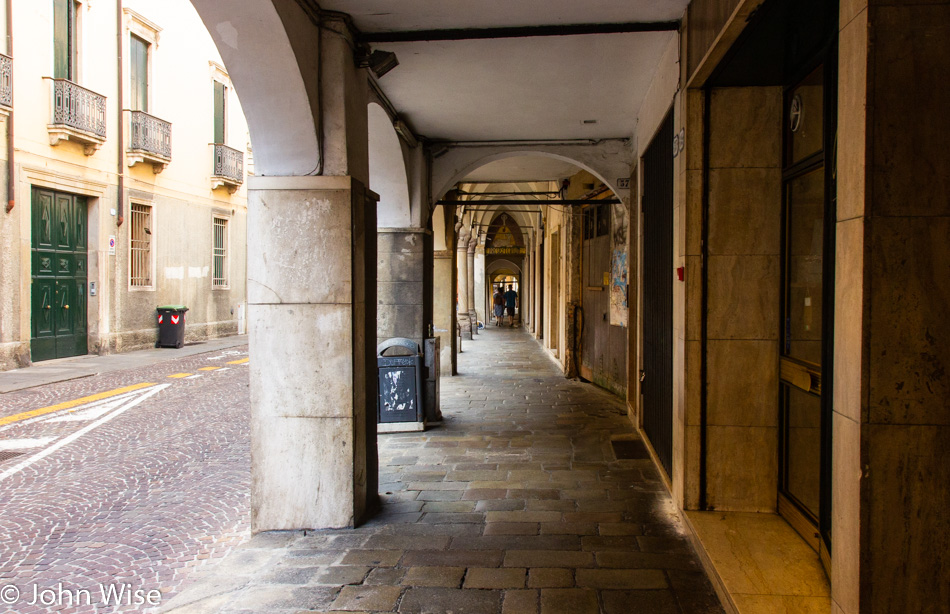
Colonnades play a large role in this city and definitely lend a distinct look to its appearance.
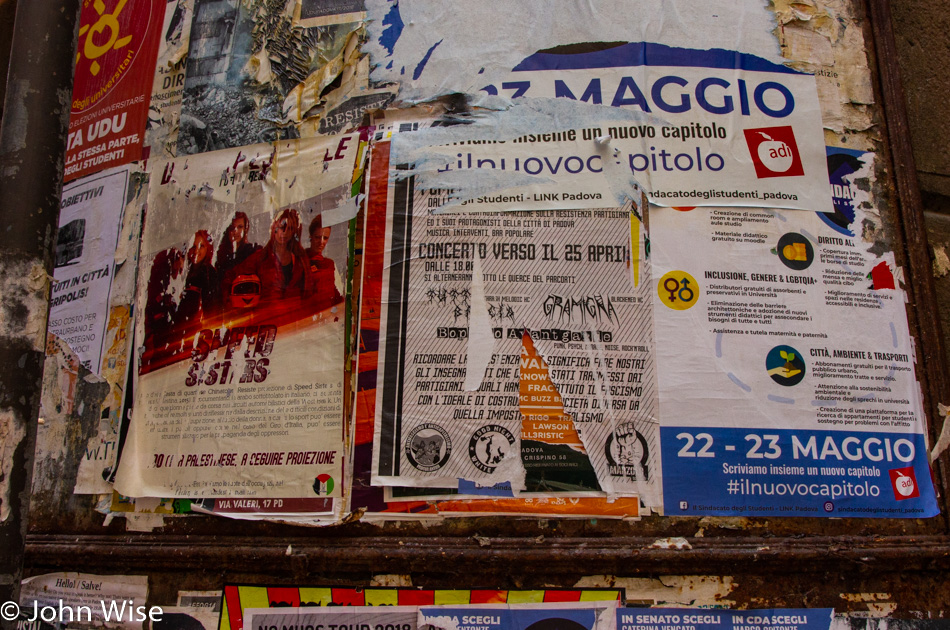
Details to fill in the points between.

Modern art meets ancient architecture.
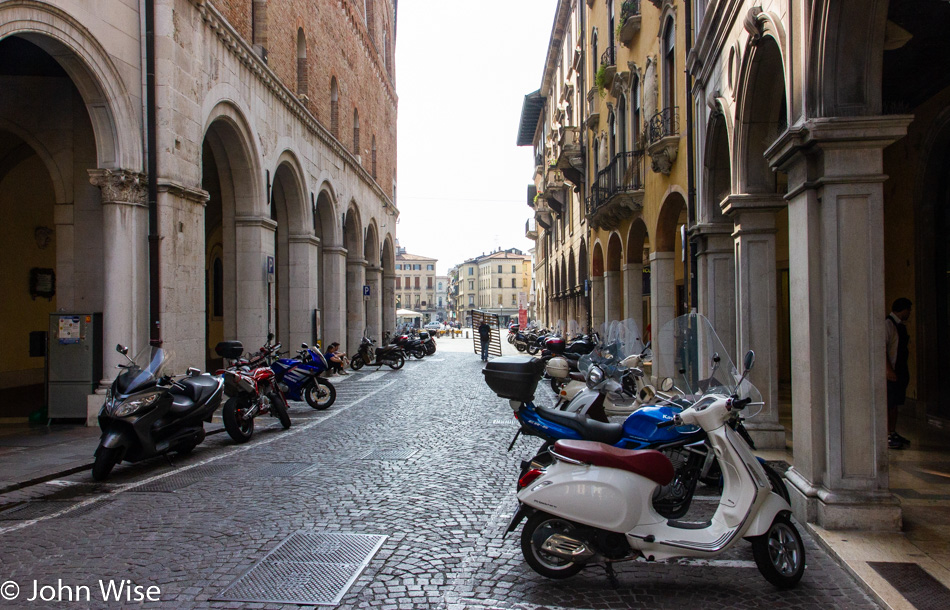
If you had to drive on these narrow streets and were stuck in traffic for any period of time, you’d quickly understand why so many Italians use Vespas, motorcycles, and bicycles to get around.
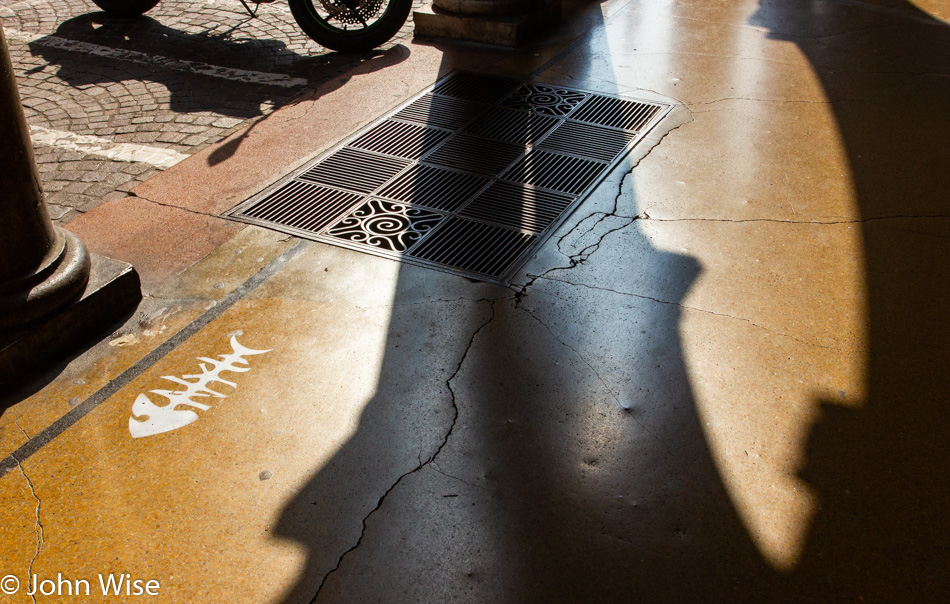
They may only be shadows and a grate somewhere else, but here on the streets of Padua, they are part of the character that helps create this city.
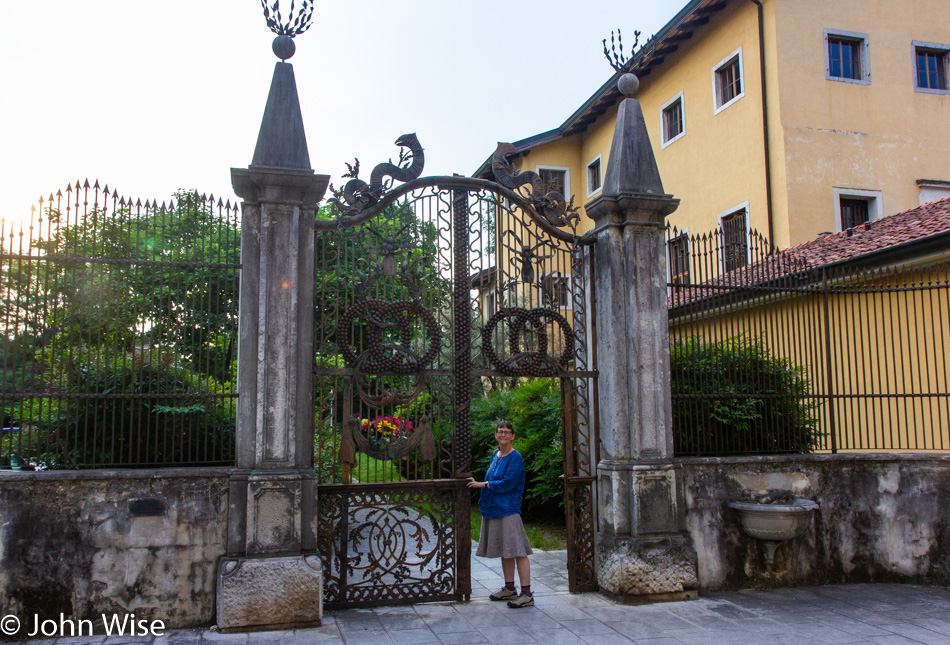
We made it out of Padua and took the main highway to Gorizia which limited our opportunity to take photos along the way, but that is just as well as this blog entry is probably the longest photo-wise of anything I’ve posted prior. This ornate gate opens to a small park next to the synagogue in Gorizia
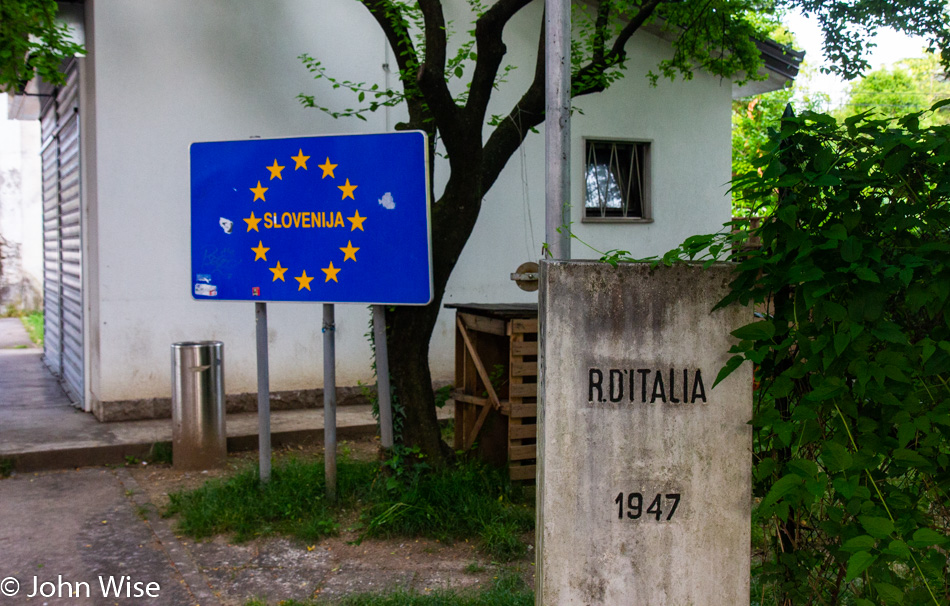
We walked a couple of miles to our restaurant in the neighboring city of Solkan, Slovenia.

It’s 7:30 p.m.

Caroline raises a toast at Gostilna Pr’Mikija as we decide what we are going to have for dinner here in Slovenia.
A side note added well after this post was first shared: at the same time the beer and mineral water was delivered, our server also set down a bowl of bread. The bread was a bit generic, white with a suboptimal crust that needed something like olive oil or butter, so I asked the server for some butter. You’d have thought I asked for ketchup in a French restaurant, as this man seemed incredulous that I’d ask for such a thing. He brought the butter, but it was delivered most peculiarly in a large bowl with well over a pound of the yellow cream chunks carved out of a much bigger block. As we looked aghast at the mountain of butter and had a laugh about the breakdown in communication, our server returned less than five minutes later to snatch it right back without a word.

Polenta, shrimp, chanterelles, and arugula were the basis of our appetizer.
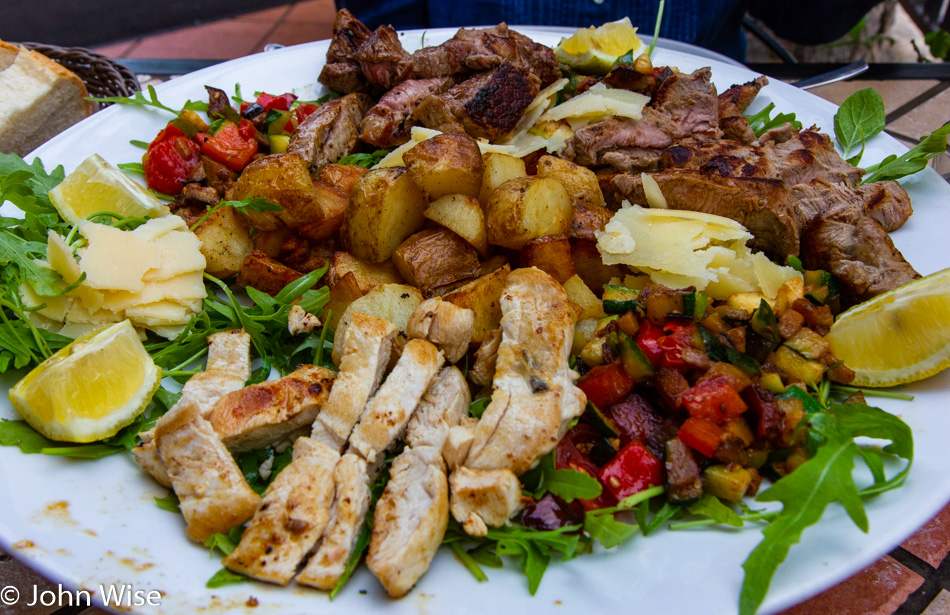
Our main shared entree was a large plate of venison, chicken, and beef with potatoes, grilled peppers, and Parmesan.

Walking back to Italy after a great dinner in Slovenia.
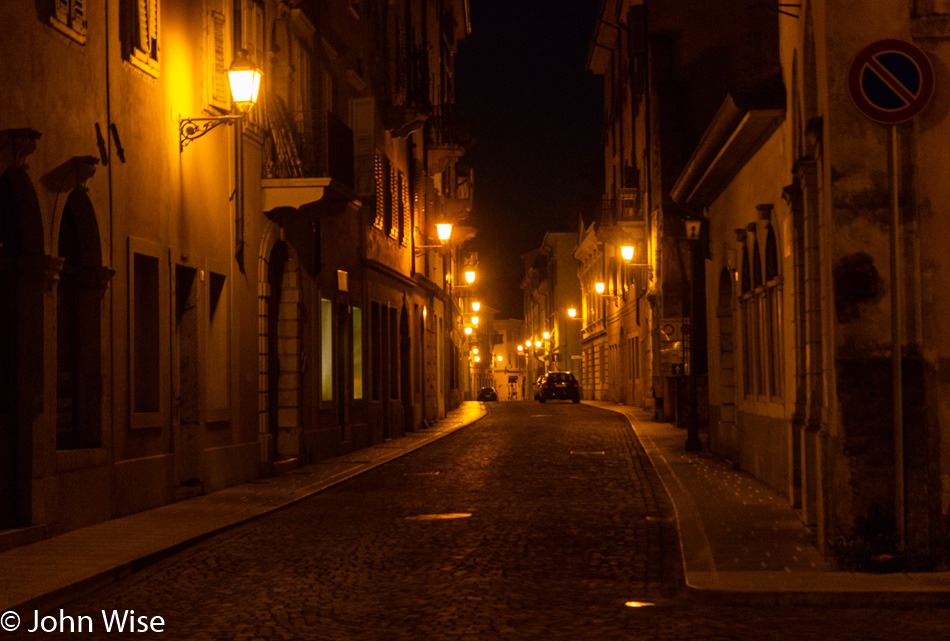
It’s 10:00 p.m. when we get back to our apartment in Gorizia. It’s quiet here in the far east of Italy. I probably didn’t write more than about a half-hour before we passed out, exhausted from a busy day loaded with a million impressions.